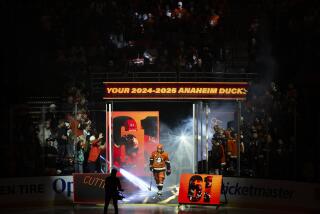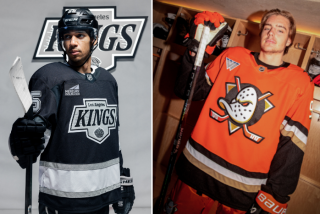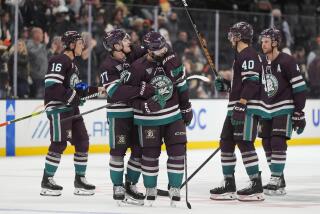MIGHTY DUCKS ‘93-94: PREMIERE SEASON : A Hockey Primer
- Share via
The Mighty Ducks’ premiere season is certain to catch the interest of both sophisticated and casual hockey fans in Orange County. A look at some of the basics of the game:
Western Conference
Pacific Division
Anaheim Mighty Ducks Anaheim Arena Anaheim 1992-93 record: None, expansion team Finish: Not applicable
Calgary Flames Olympic Saddledome Calgary, Canada 1992-93 record: 43-30-11, 97 points Finish: Second, Smythe
Edmonton Oilers Northlands Coliseum, Edmonton, Canada 1992-93 record:26-50-8, 60 points Finish: Fifth, Smythe
Los Angeles Kings The Forum, Inglewood 1992-93 record: 39-35-10, 88 points Finish: Third, Smythe Division
San Jose Sharks San Jose Arena, San Jose 1992-93 record: 11-71-2, 24 points Finish: Sixth, Smythe
Vancouver Canucks Pacific Coliseum, Vancouver, Canada 1992-93 record: 46-29-9, 101 points Finish: First, Smythe
Central Division
Chicago Blackhawks Chicago Stadium, Chicago 1992-93 record: 47-25-12, 106 points Finish: First, Norris
Dallas Stars Reunion Arena, Dallas 1992-93 record: 36-38-10, 82 points* Finish: Fifth, Norris
Detroit Red Wings Joe Louis Arena, Detroit 1992-93 record: 47-28-9, 103 points Finish: Second, Norris
St. Louis Blues St. Louis Arena, St. Louis 1992-93 record: 37-36-11, 85 points Finish: Fourth, Norris
Toronto Maple Leafs Maple Leaf Gardens, Toronto 1992-93 record: 44-29-11, 99 points Finish: Third, Norris
Winnipeg Jets (As Minnesota North Stars)
Winnipeg Arena, Winnipeg, Canada 1992-93 record: 40-37-7, 87 points Finish: Fourth, Smythe Eastern Conference
Atlantic Division
Florida Panthers Miami Arena, Miami 1992-93 record: None, expansion team Finish: Not applicable
New Jersey Devils Meadowlands Arena, East Rutherford, N.J. 1992-93 record: 40-37-7, 87 points Finish: Fourth, Patrick
New York Islanders Nassau Coliseum, Uniondale, N.Y. 1992-93 record: 40-37-7, 87 points Finish: Third, Patrick
New York Rangers Madison Square Garden, New York 1992-93 record: 34-39-11, 79 points Finish: Sixth, Patrick
Philadelphia Flyers The Spectrum, Philadelphia 1992-93 record: 36-37-11, 83 points Finish: Fifth, Patrick
Tampa Bay Lightning Suncoast Dome, St. Petersburg, Fla. 1992-93 record: 23-54-7, 53 points Finish: Sixth, Norris
Washington Capitals USAir Arena, Landover, Md. 1992-93 record: 43-34-7, 93 points Finish: Second, Patrick
Northeast Division
Boston Bruins Boston Garden, Boston 1992-93 record: 51-26-7, 109 points Finish: First, Adams
Buffalo Sabres Memorial Auditorium, Buffalo, N.Y. 1992-93 record: 38-36-10, 86 points Finish: Fourth, Adams
Hartford Whalers Civic Center, Hartford, Conn. 1992-93 record: 26-52-6, 58 points Finish: Fifth, Adams
Montreal Canadiens The Forum, Montreal 1992-93 record: 48-30-6, 102 points Finish: Third, Adams
(1993 champs) Ottawa Senators Ottawa Civic Centre, Ottawa 1992-93 record: 10-70-4, 24 points Finish: Sixth, Adams
Pittsburgh Penguins Civic Arena, Pittsburgh 1992-93 record: 56-21-7, 119 points Finish: First, Patrick
Quebec Nordiques Le Colisee, Quebec City 1992-93 record: 47-27-10, 104 points Finish: Second, Adams
Outfitting the Players
* Helmet: Polyethylene plastic with pockets of polyethylene injected inside helmet for strengthening. Round shape makes for a snug fit; helps to deflect, rather than absorb, impact.
* Shoulder pads: Built-in plastic shoulder caps lined with foam to deflect impact. Pads have arches that run from front to back to reduce risk of shoulder separation.
* Jersey: Reinforced elbows, shoulders. Rumble strap in back ties jersey to pants so opposing player can’t pull jersey over player’s head during a fight.
* Suspenders: Almost obsolete; most players wear belts.
* Pants: Densely stitched knit treated with anti-fraying compound for durability. Upper shell lined with foam to protect hips, kidney and tailbone. Foam lining in lower shell protects outer and inner thigh and back of leg.
* Garter belt: Holds up socks using basic hook attachment. New hockey underwear has Velcro that latches onto socks; garter belts might soon go the way of suspenders.
* Stick: Up to 67 inches long with various curves, called lies, of the blade. Most players use several sticks with different lies during a game. The favorite: standard wood stick constructed of several layers of ash wrapped in fiberglass. Aluminum, composite graphite and boron shafts are gaining in popularity.
* Gloves: Leather outer shell; inside is soft foam. Thumb composed of three pieces to allow forward and side movement but prevent backward movement that can cause breaks and sprains.
* Puck: six ounces; 3 inch diameter by 1 inch high; galvanized steel inside vulcanized rubber.
* Shin guard: Different stitching patterns are used to allow movement and provide durability.
* Skates: New design combines Reebok’s pump system with skate boot. During a game, feet change size; pump adjustments mean players don’t waste time relacing.
Goalie
* Mask: Cage allows greater visibility than solid fiberglass masks; more NHL goalies are wearing this mask.
* Catching glove: Has built-in fiberglass deflector covered with leather to push the puck down rather than up. Catching glove can be up to 16 inches in diameter.
* Goalie stick: Broader shaft and blade provide goalie with greater opportunity to deflect puck.
* Goalie shin guard: Polypropylene slat is built into shin guard to prevent it from collapsing under pressure of a puck hitting at 90 mph.
Dimensions on Ice
Rink: 200 feet long by 85 wide. Some (Chicago Stadium, Memorial Auditorium in Buffalo) are less than regulation because they were grandfathered in when the rule for regulation rink was set. Any new building must meet 200 by 85 requirement.
Goal: 6 feet wide by 4 feet deep. Red metal posts that sit on Marsh-peggs, designed to allow the goal to break free from its moorings if players crash into it.
End zone (boards to goal line): 10 feet
Goal line to blue line: 60 feet
Neutral zone (between blue lines): 60 feet
When rink is not to regulation length, only neutral zone is affected. Regardless of arena, rink is always the same width. Distance from blue lines to the back boards always are the same.
Breaking the Rules
Only the referee--not the two linesmen--can send a player to the penalty box. If the referee doesn’t see it, it didn’t happen.
High Sticking: Holding stick above shoulder while checking a player. Usually a minor penalty (2 minutes). If blood is drawn, a major (5 minutes) or a misconduct (ejection for at least the rest of that game) can be called.
Tripping: Usually done with a stick, but not necessarily; normally a minor. If done on a breakaway, a penalty shot should be called; emphasize should .
Spearing: Skewering an opposing player with the blade of the stick. A major.
Hooking: Impeding player’s progress from behind by placing stick blade around the midsection. Giving the stick a hard yank at the same time helps earn the minor.
Slashing: Emphatically tapping or slapping opponent’s body (usually arms or legs) with a stick. A minor unless referee determines stick swinging deserves a major.
Cross-Checking: Hitting an opponent with both hands on your stick and blade off the ice. Traditionally done in a pushing motion across chest, face or back. A minor unless blood is drawn.
Icing: Shooting puck from behind the center (red) line to the opponent’s goal line without it being touched. Defending team must touch it behind the goal line for the call. If attacking team touches it before defenders, or referee determines defenders could have touched it before it crossed the goal line, call is “waved off.” Not called against a team that is short-handed.
Offside: 1. Called when an attacking player precedes the puck across the defending team’s blue line.
2. Two-line offside is called when the puck, passed forward, crosses a red and blue line, then is touched by an attacking player.
Sources: NHL Guide and Record Book, Rules of the Game, Canadian Cycles and Motors, The Hockey Encyclopedia
Researched by MARK PARGAS Aand APRIL JACKSON / Los Angeles Times
More to Read
Go beyond the scoreboard
Get the latest on L.A.'s teams in the daily Sports Report newsletter.
You may occasionally receive promotional content from the Los Angeles Times.






